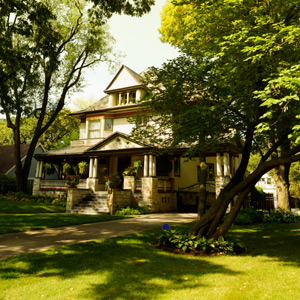
You’re relocating and have a few days to find your dream house – or at least a house you can call home. Housing inventory is tight, so you might wonder, “Should I buy an old house?” There are advantages and disadvantages of buying an old house.
While older homes have their charms, there are some questions to ask when buying an old house. Here is a buying an old house checklist of things to consider:
- Energy efficiency: Older homes generally have lower energy efficiency ratings than newer homes. Consider the potential costs of upgrading insulation, installing energy-efficient appliances, or implementing other energy-saving measures.
- Lead paint: If the home was built before 1978, have it tested for lead paint by a certified inspector. Due to the strict protocol involved, removing lead paint is costly and should be done by professionals.
- Asbestos: Older homes may contain asbestos in insulation, flooring, or other areas. Inspections can identify its presence, and you should consider having it removed if it’s in poor condition.
- Radon: Test the home for radon, a naturally occurring gas that can cause lung cancer. Mitigation options are available if radon levels are high.
- Pest infestations: Older homes can be more susceptible to pests like termites, ants, or rodents. Conduct a thorough inspection for any signs of infestation and consider hiring a pest control expert if necessary.
- Insulation: Have a building inspector evaluate the home’s insulation and offer recommendations for improvement if necessary.
- Old heating systems: Older heating systems, especially those fueled by oil, are typically inefficient. Consider budgeting for a new heating system, which will eventually pay for itself in energy savings. Don’t forget to assess the condition of the fireplace and chimney as well.
- Inefficient windows: Look for cracks, gaps, and rotting wood in window frames, as well as single-pane glass. In restoration homes, preservation often takes priority over energy efficiency. Restoring or replacing windows can be costly but can help improve energy efficiency.
- Foundation issues: Check the foundation for cracks and structural damage, particularly if there is a basement. Watermarks in the basement indicate foundation leaks, which can lead to mold, termites, and rot.
- Roof condition: Assess the roof’s condition as it might need repairs or replacement. Look for missing or damaged shingles, signs of leaks, or sagging areas. A professional inspection can provide a more accurate assessment.
- Electrical service and wiring: Check the electrical system to ensure it meets modern standards. Older homes may have lower amp capacity and ungrounded wiring, which may need upgrading.
- Plumbing: Older homes may have outdated plumbing systems prone to leaks and clogs. Inspect the pipes for signs of corrosion and check if the water pressure is adequate. Consider budgeting for plumbing updates if needed.
- Awkward kitchens and old bathrooms: Older homes often have outdated kitchen and bathroom layouts. These areas may require costly remodels, but they can also provide opportunities for creative transformations.
- Lack of storage: Older homes may have limited storage space, with bedrooms lacking closets, few kitchen cabinets, or crawl-space basements. Consider whether reconfigurations or expansions are feasible.
- Maintenance and upkeep: Older homes often require more maintenance than newer homes. Consider the time and effort needed to maintain the property, especially if you’re not experienced with home repairs and maintenance tasks.
- Neighborhood and amenities: Research the community where the home is located. Consider proximity to schools, parks, shopping centers, and public transportation. Additionally, examine the resale value and growth potential of the area.
- Resale potential: Consider the demand for older homes in the market and the potential resale value. While many people appreciate the character of older homes, others may prefer modern features and amenities. Consider the long-term investment potential of the property.
- Historical considerations: If the home is located in a historical district or has historical significance, there may be restrictions on modifications or renovations. Ensure you understand any regulations that may affect your plans for the property.
- Historic charm and character: Older homes’ main attractions are their unique architectural features and historical charm. Consider whether preserving and restoring these features aligns with your personal preferences and vision for the property.
- Homeowners Association (HOA) restrictions: Review the HOA rules and regulations if the home is part of a homeowners association. Understand any fees, restrictions on modifications, or other requirements that may impact your enjoyment of the property.
Remember to consult with professionals such as inspectors, contractors, and real estate agents who have experience with older homes. They can help guide you on what to look for when buying an old house. As always, a TRC Relocation Counselor is happy to be your sounding board as you make this decision.
Meeting with contractors to determine the feasibility and estimated costs of any desired renovations or improvements is particularly important. Budget for unexpected expenses, as additional issues may be uncovered during renovation. Finally, be prepared for the time and patience required to see the renovation through, especially after the stress of relocating.




